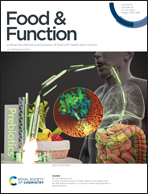Metabolomics-based evidence of the hypoglycemic effect and alleviation of diabetic complications by Ficus racemosa fruit in diabetic mice†
Abstract
The hypoglycemic and metabolic effects of Ficus racemosa fruit were studied in diabetic mice, and its potential mechanisms of hypoglycemic activity and its alleviation of diabetic complications were explored using a metabolomics approach. The histopathological effect of Ficus racemosa fruit was characterized by hematoxylin and eosin histological staining. Dynamic fasting blood glucose (FBG), postprandial glucose (PPG), body weight, and biochemical parameters, including hepatic-renal function and lipid levels, were monitored to confirm the hypoglycemic activity and attenuation effect. The metabolomics analysis was performed using the established platform, combining liquid chromatography–tandem mass spectrometry with statistical analysis to identify the metabolites internally regulated by Ficus racemosa fruit. Desorption electrospray ionization-mass spectrometry imaging (DESI-MSI) was employed to explore the presence and spatial distribution patterns of differential molecules further. An inhibition of blood glucose levels and improvements in tissue lesions were observed after Ficus racemosa fruit treatment, especially with high-dose treatment. Ficus racemosa fruit primarily induced metabolomic alterations in amino acids, organic acids and nucleotides, and displayed a systematic effect, which involved the mediation of amino acid metabolism, glucose metabolism, energy metabolism and lipid accumulation. The effect of Ficus racemosa fruit on the liver was primarily discussed in this study, and it regulated purine metabolism, glycolysis/gluconeogenesis, arginine biosynthesis, histidine metabolism, alanine, aspartate and glutamate metabolism, and the citrate cycle. Through the mediation of related pathways or single molecules that could affect insulin resistance, insulin secretion or FBG, e.g., the amino acid histidine or the organic acid uric acid in the liver, Ficus racemosa fruit achieved its hypoglycemic effect and alleviated diabetic complications in the liver. The results of the tissue metabolomic analysis, histopathological analysis, plasma biochemical parameters, plasma metabolite analysis and tissue DESI-MSI analysis were consistent with one another. The present study provides the evidence of the hypoglycemic effect and its alleviation of diabetic complications for Ficus racemosa fruit as well as the scientific support for its traditional use.



 Please wait while we load your content...
Please wait while we load your content...